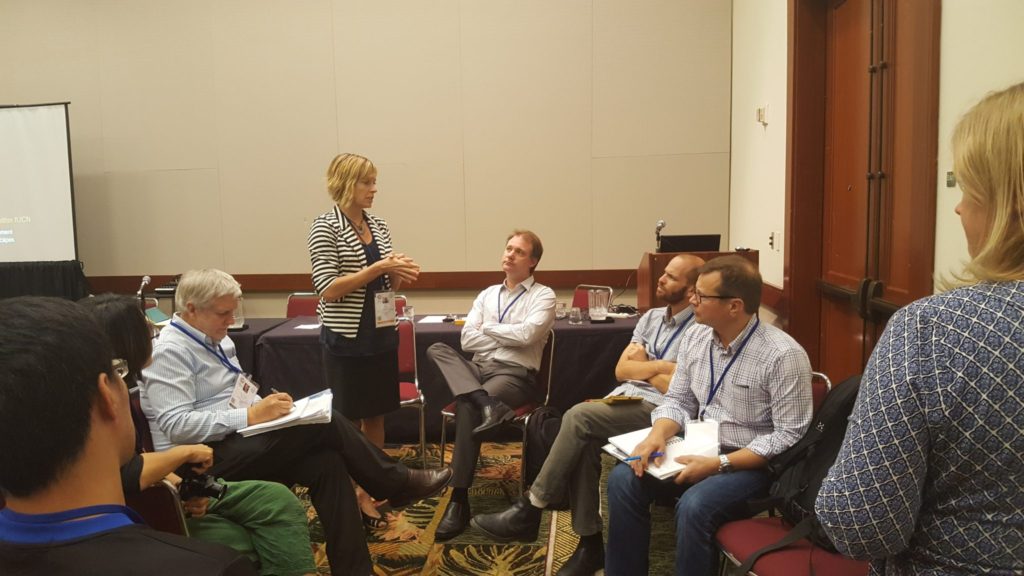Fulbright scholarship-winning doctoral student Rina Hauptfeld doesn’t wear a cape, but she’s attempting to save the night and turn down the volume. Hauptfeld, along with the Natural Sounds and Night Skies Division of the U.S. National Park Service and Colorado State University’s Center for Protected Area Management, is seeking to increase attention to, and help mitigate, sensory pollution in parks and protected areas globally.
As a CPAM research assistant, Hauptfeld is conducting a global inventory of initiatives that mitigate noise and light pollution on ecological and human communities, under the supervision of CPAM co-directors Jim Barborak and Ryan Finchum. The inventory includes legislative, policy, educational, and technological measures that address light and noise pollution in protected areas at local, national, and international scales. This repository and accompanying geo-tagged map will be released in mid-2017.
This inventory was recently debuted at the International Union for Conservation of Nature-convened World Conservation Congress in Honolulu, Hawaii. WCC is the largest conservation congress in the world with nearly 10,000 delegates from 190 countries. This is not the first time that CPAM has been on the world stage.
Wildlife Does Not Like Noise Either
“Healthy people need healthy parks, and this requires efforts to protect the night skies which have inspired mankind for millennia, and to keep anthropogenic noise to a minimum to reduce wildlife and human health impacts,” stated Barborak.
Studies have shown that anthropogenic noise can cause hearing loss in wildlife, mask important environmental cues, create migration barriers, cause physiological effects (increased heart rate, respiration, and stress), and produce negative? behavioral impacts. Preservation of natural sounds are important because, “whether quiet or booming, they play myriad important roles, from helping animals to locate mates and prey (or avoid predation), to lowering heart rates and cortisol levels in humans,” added Hauptfeld.
As part of their collaborative agreement, CPAM and NPS organized a high-profile workshop,Natural Sounds and Healthy Parks: Global Research and Initiatives, one of just two events in the over 1300 at
WCC that addressed anthropogenic noise pollution. The workshop featured global leaders discussing current and emergent research on human and ecological impacts of noise pollution, and reviewing initiatives that address the need to reduce noise inside and outside of protected areas. Subsequent breakout sessions from the workshop sought to deliver tangible outputs through identifying research gaps, best practices and policies to protect soundscapes, and mechanisms to promote cooperation within IUCN.
The workshop led to the establishment of an international working group on natural sounds and protected areas, the Natural Sounds Advisory Group , within the World Commission on Protected Areas. NSAG is focused on the understanding and regulating noise as it affects protected areas, nature, and natural soundscapes, as well as people and cultural resources more generally. Hauptfeld stated that, “the NSAG is being established at a key time, when the international conservation and research community is increasingly aware of a spectrum of impacts that anthropogenic noise has on humans and wildlife. The advisory group can play an important role focusing conservation and development policies to reflect these new understandings at the global level, both inside and outside of parks.”
Hero by Day
Researchers in protected areas aren’t often described as heros, however the need for them has never been greater. Protected areas cover 15% of the earth’s land surface and 10% of territorial seas. As mineral extraction draws closer to the borders of many protected areas, park visitation increases each year, biodiversity shrinks, climate change affects species and ecosystems, and developmental sprawl increases, the work to effectively manage protected areas and to protect natural soundscapes and night skies in these areas is becoming more crucial.
“For current and future prosperity we need a planet that can continue to provide essential environmental services to support human well-being and the well-being of the other species we share this planet with,” said Finchum. “Protected areas are one of the most proven and widely accepted vehicles for achieving long-term environmental protection of a whole host of services that we draw benefit from. For posterity’s sake, we want to leave behind a world worth living in. By setting aside special places that we visit but largely do not develop, we leave a legacy for all future generations. This legacy will provide our great-grandchildren with places to play and learn, to pray and earn a living. Protected areas are areas that we protect not from people, but for people.”
It’s What You Do That Defines You
Provisional members of the IUCN WCPA Natural Sounds Advisory Group hold an organizational meeting to co-create objectives for the next four years.
At the recent WCC Finchum was recognized for his extensive work in parks and protected areas by being named to the steering committee for capacity building for the IUCN World Commission on Protected Areas. For Finchum, it is an honor to personally represent CSU and CPAM on the IUCN WCPA capacity building steering committee. Finchum added that, “there are just a handful of people from around the world that have been invited to serve this committee that is undertaking an extremely aggressive strategic plan that will build over the next 10 years towards the next World Parks Congress.”
CPAM is a part of The Department of Human Dimensions of Natural Resourcesin The Warner College of Natural Resources, and contributes to the conservation, planning, and management of the world’s protected areas, through capacity building, applied research, and collaboration with organizations that help manage them and the communities that depend on them.


